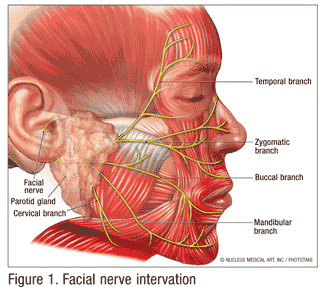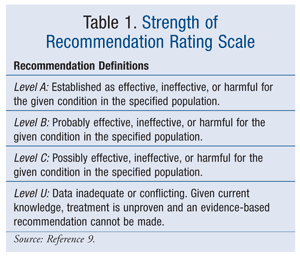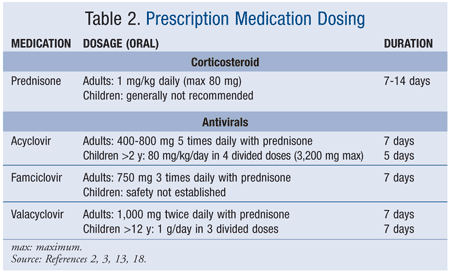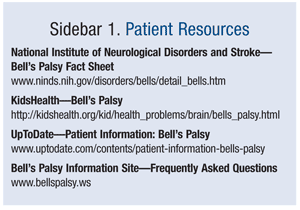Bell’s palsy is an acute unilateral peripheral paralysis or weakness of the face that may lead to permanent disfigurement to the affected side of the face.1-3 In 1821, the Scottish surgeon and anatomist Sir Charles Bell was the first to the describe this syndrome, as well as the function and anatomy of the facial nerve.2 The use of pharmacologic agents has been controversial in the past owing to inconsistent efficacy and the high rate of spontaneous recovery. Recent studies have shown with increasing confidence that certain pharmacologic agents, such as corticosteroids and antivirals, may be beneficial and can effect clinical improvements in the patient.
EPIDEMIOLOGY
Worldwide, the incidence of Bell’s palsy ranges from 20.2 (United Kingdom) to 53.3 (Italy) per 100,000 population.4,5 About 40,000 people in the United States (13 per 100,000) receive this diagnosis, making it one of the most common causes of facial-nerve palsy.6,7 The disease affects men and women in equal numbers and without a predilection for either side of the face.2 Pregnant women, individuals with diabetes, and those with upper respiratory ailments are more commonly affected.2,6 Although Bell’s palsy occurs at all ages (uncommonly in ages <15 and >60 years), individuals aged 30 to 45 years have the highest incidence.2,6,8 Roughly 71% of patients with Bell’s palsy recover completely without treatment; however, in the U.S., more than 8,000 patients each year are left with some permanent facial weakness.9
ETIOLOGY
Bell’s palsy is often described as idiopathic. However, current evidence suggests a possible viral pathogenesis with herpes simplex virus type 1 (HSV-1).2,7 Recent molecular analyses by means of polymerase chain reaction have shown latent HSV genome in the geniculate ganglia, as well as active HSV segments in the endoneural fluid of the facial nerve (FIGURE 1).7 Therefore, it is believed that patients experience inflammation because of reactivated HSV causing mechanical compression and possible demyelination and ischemia of the facial (seventh cranial) nerve in the geniculate ganglion.2,10 This results in paralysis of all the muscles involved in facial expression on the affected side of the face.2 The seventh cranial nerve innervates the salivary and lacrimal glands and is involved with taste to the anterior two-thirds of the tongue.2

CLINICAL PRESENTATION
Most often, at symptom onset, patients believe that they have suffered a stroke or have an intracranial tumor.11 Individuals present with abrupt unilateral weakness or complete paralysis resulting in drooping of the eyebrow and the corner of the mouth.2,3 Patients commonly complain of facial numbness or eye irritation.2 A condition referred to as Bell’s phenomenon occurs when the eye rolls upward on attempted closure, while the eyelid does not close and the lower eyelid droops.2,11 Another visual clinical manifestation is asymmetry in the patient’s smile that is caused by paralysis.10 Other symptoms include facial or retroauricular (behind the ear) pain, altered taste, increased sensitivity to certain sounds, dry eyes or excessive tearing, and drooling.6,11 Most often, symptoms progress rapidly after onset, with maximal facial weakness seen within 2 days to 1 week.2,11 Other conditions that can cause symptoms that mimic Bell’s palsy, although uncommon, include Lyme disease, hypertension, tumors of the ear or parotid gland, Guillain-Barré syndrome, sarcoidosis, amyloidosis, eclampsia, and otitis media.2,3
TREATMENT
Pharmacologic Treatment
The most recent clinical guidelines by the American Academy of Neurology (AAN), published in 2001, offer a starting point for assessing the most prudent therapy strategies.9 The recommendations issued in the report were assigned a rating based on the committee’s confidence regarding therapeutic effectiveness. A four-tier rating system—levels A, B, C, and U—was used (TABLE 1 offers a more detailed description).9 Numerous studies published in the last few years provide an update on the efficacy of the two primary treatment options. Overall, the two main goals of treatment are reducing recovery time and preventing ocular complications.11

The optimal strategy for treating patients with Bell’s palsy is still being debated because of conflicting data regarding medication efficacy. Compounding the issue is the fact that researchers do not fully understand the etiology of the disease. However, the prognosis is highly promising for the majority of patients. Without treatment, 71% of patients will achieve full recovery and 84% will achieve near-normal functioning.9 Even though a high percentage of patients recover full facial functioning, a considerable number of patients may have only partial recovery.2 The effectiveness of drug therapy is optimized by starting treatment early ( <72 hours prior to onset of symptoms).7 Therefore, the need to start drug therapy can be compelling.
Currently, there are no FDA-approved drugs for treatment, but the two most commonly recommended pharmacologic options are corticosteroids and antivirals. The current debate centers around the use of corticosteroids alone versus their use with antivirals.12 At present, evidence suggests that corticosteroids used alone have a beneficial effect, antivirals used alone are no more effective than placebo, and corticosteroids plus antivirals can produce a higher percentage of full recovery than corticosteroids alone.2,9 The current dosing recommendations are found in TABLE 2.

Corticosteroids: There is more credible evidence for the use of corticosteroids than for the use of antivirals. Several different corticosteroids have been used in the past, including hydrocortisone, methylprednisolone, prednisolone, and dexamethasone. Currently, prednisone is the form most commonly used.1,9 Corticosteroids work by suppressing inflammation and the body’s natural immune response found in the facial nerve responsible for facial paralysis.13,14 The practice parameter issued by the Quality Standards Subcommittee of the AAN in 2001 concludes that oral “…steroids are safe and probably effective in improving facial functional outcomes in patients with Bell’s palsy”(level B recommendation).9 The most recent data regarding the effectiveness of oral corticosteroids come from a 2010 Cochrane Review, which concluded that current randomized, controlled trials showed “significant” positive outcomes from corticosteroid therapy in patients with Bell’s palsy.14
In addition, the studies evaluated in this Cochrane Review found no serious side effects from corticosteroid treatment, making its use more advantageous.2,14 Dosages varied among the different studies; however, prednisone 1 mg/kg orally once daily for 7 to 14 days has been recommended ( <80 mg).13 The dose may be tapered in the second week of therapy if treatment extends to 14 days. Since Bell’s palsy does not typically occur in children, dosage recommendations are not commonly listed. One study has suggested 2 mg/kg daily for 7 to 10 days.2
Antivirals: Because of the suspected causative viral etiology of HSV-1, antivirals such as acyclovir, valacyclovir, and famciclovir theoretically should be of benefit.2,13 Antivirals work by inhibiting viral DNA polymerase, ultimately leading to inhibition of viral DNA synthesis.13 The use of these medications as monotherapy is not recommended, according to the Cochrane Review: “High quality evidence from randomized controlled trials of herpes simplex antivirals for the treatment of Bell’s palsy showed no significant benefit from antivirals compared to placebo.”8 The Cochrane Review also noted that when antivirals and placebo were compared, participants showed little difference in recovery. A plausible answer for the lack of efficacy is that an immunologic reaction occurs that produces increased local inflammation and exacerbation of symptoms due to the antiviral medication itself, even though the drug is active against the causative virus. This is known as Jarisch-Herxheimer reaction.8
The practice recommendations issued by the AAN do not address the use of antivirals as monotherapy.9 However, according to recent studies, antivirals given in combination with corticosteroids may be of benefit.1,10 The recommended dosing for acyclovir in children aged >2 years is 80 mg/kg in four divided doses for 5 days (maximum 3,200 mg daily).2 For valacyclovir, the recommendation for children aged >12 years is 1 g daily in three divided doses for 7 days.2 The safety of famciclovir in children has not been established.
Combination Therapy: The use of antivirals and corticosteroids has been highly controversial in the past because of conflicting evidence. The two most common antivirals studied are acyclovir and valacyclovir. According to the AAN’s practice guidelines, “Early treatment with acyclovir in combination with prednisone is recommended as possibly effective to improve facial functional outcomes” (level C recommendation).9 The Cochrane Review reported that, compared with placebo, considerable benefit was seen with combination therapy of antivirals and corticosteroids.8
It has been suggested by Thaera and colleagues that antiviral agents plus corticosteroids may have a beneficial synergistic effect on recovery, with “borderline significance” compared with corticosteroids given alone.10 Therefore, patients who present within 3 days of onset should receive combination therapy unless medication contraindications exist.2,7,11,15 The rationale is threefold. First, countless studies have reiterated an acceptable safety profile for both antivirals and corticosteroids.2,16 Second, the cost of therapy is reasonable. For one commonly prescribed regimen, acyclovir and prednisone, both medications are available generically and may be easily obtained by patients without insurance.1 Third, although this disease state is not fully understood, the possibility of preventing long-term sequelae without inducing more harm would be in the best interest of the patient.2
Nonpharmacologic Treatment
Nonpharmacologic treatment options include physical therapy, surgery, transcutaneous electrical nerve stimulation (TENS), and acupuncture.11 Physical therapy involving facial exercises and massage may be an option, although the effectiveness is not known.11 In the past, decompression surgery was an option to relieve stress on the facial nerve, but the benefits currently do not outweigh the risks, and permanent postoperative hearing loss has been reported in up to 15% of patients undergoing this procedure.2,11 Therefore, the AAN states, “There is insufficient evidence to make recommendations regarding the use of facial nerve decompression to improve facial functional outcomes”(level U recommendation).9 Further studies are needed to determine the effectiveness of both TENS and acupuncture.11 Reports have described limited effectiveness of methylcobalamin and other vitamins, including B12 and B6; zinc; hyperbaric oxygen; mime therapy; and botulinum toxin.6,11
Eye Care: Often, patients are unable to completely close their eyelids, or the eyelids tend to droop, resulting in dryness or irritation.2 Therefore, patients should be instructed to use eye lubricants such as artificial tears hourly and eye ointments at night because of the possibility of eye irritation from the facial paralysis.2 In addition, patients may need to wear full-protection goggles or an eye patch to protect against foreign objects.17 Finally, patients should protect their eyes from direct sunlight by wearing sunglasses when outside for extended periods.17 These precautions should be continued until the facial paralysis is resolved.2
PHARMACIST INVOLVEMENT
Pharmacists typically interact with Bell’s palsy patients through counseling about their prescribed medications and nonprescription eye care products. Pharmacists should reinforce adherence to prescribed medications at the appropriate dose and for the necessary duration.17 Patients should never abruptly stop or temporarily discontinue any medication without talking to their prescribing physician.17 Patients should also be educated regarding the possibility of side effects from corticosteroids and antivirals. Corticosteroids such as prednisone can have potentially serious adverse effects, such as blurred vision, cataracts, weakness, swelling of feet, and weight gain.17 Antivirals such as acyclovir can cause adverse effects including confusion, behavior changes, agitation, and weakness.17 Although these effects are uncommon, they can negatively impact patients’ health and well-being, as well as their adherence to treatment. Thorough counseling can help patients avoid additional problems. See SIDEBAR 1.

CONCLUSION
Because of the high rate of spontaneous recovery, some experts question the use of pharmacologic agents. However, given the possibility of preventing potential permanent sequelae, pharmacologic therapy should be warranted. Both the AAN guidelines and the Cochrane Review Board reiterate that the use of corticosteroids is efficacious for the treatment of Bell’s palsy. Historically, the use of corticosteroids and antivirals in combination has been controversial, but the most recent expert opinion is shifting toward a possible increased benefit with concurrent use.
REFERENCES
1. de Almeida JR, Al Khabori M, Guyatt GH, et al. Combined corticosteroid and antiviral treatment for Bell palsy: a systematic review and meta-analysis. JAMA. 2009;302:985-993.
2. Tiemstra JD, Khatkhate N. Bell’s palsy: diagnosis and management. Am Fam Physician. 2007;76:997-1002,1004.
3. Gilden DH. Bell’s palsy. N Engl J Med. 2004;351:1323-1331.
4. Rowlands S, Hooper R, Hughes R, Burney P. The epidemiology and treatment of Bell’s palsy in the UK. Eur J Neurology. 2002;91:63-67.
5. Monini S, Lazzarino AI, Iacolucci C, et al. Epidemiology of Bell’s palsy in an Italian Health District: incidence and case-control study. Acta Otorhinolaryngol Ital. 2010;304:198.
6. National Institute of Neurological Disorders and Stroke. Bell’s palsy fact sheet.
www.ninds.nih.gov/disorders/
7. Hato N, Yamada H, Kohno H, et al. Valacyclovir and prednisolone treatment for Bell’s palsy: a multicenter, randomized, placebo-controlled study. Otol Neurotol. 2007;28:408-413.
8. Lockhart P, Daly F, Pitkethly M, et al. Antiviral treatment for Bell’s palsy (idiopathic facial paralysis). Cochrane Database Syst Rev. 2009;(4):CD001869.
9. Grogan PM, Gronseth GS. Practice parameter: steroids, acyclovir, and surgery for Bell’s palsy (an evidence-based review): report of the Quality Standards Subcommittee of the American Academy of Neurology. Neurology. 2001;56:830-836.
10. Thaera GM, Wellik KE, Barrs DM, et al. Are corticosteroid and antiviral treatments effective for Bell palsy?: a critically appraised topic. Neurologist. 2010;16:138-140.
11. Holland NJ, Weiner GM. Recent developments in Bell’s palsy. BMJ. 2004;329:553-557.
12. Quant EC, Jeste SS, Muni RH, et al. The benefits of steroids versus steroids plus antivirals for treatment of Bell’s palsy: a meta-analysis. BMJ. 2009;339:b3354.
13. Clinical Pharmacology [online database]. Tampa, FL: Gold Standard, Inc; 2010.
www.clinicalpharmacology.com [subscription required]. Accessed November 11, 2010.
14. Salinas RA, Alvarez G, Daly F, Ferreira J. Corticosteroids for Bell’s palsy (idiopathic facial paralysis). Cochrane Database Syst Rev. 2010;(3):CD001942.
15. Hato N, Murakami S, Gyo K. Steroid and antiviral treatment for Bell’s palsy. Lancet. 2008;371:1818-1820.
16. Sullivan FM, Swan IR, Donnan PT, et al. Early treatment with prednisolone or acyclovir in Bell’s palsy. N Engl J Med. 2007;357:1598-1607.
17. Micromedex Healthcare Series: CareNotes. Bell’s palsy: general information.
www.thomsonhc.com/carenotes/
18. Minnerop M, Herbst M, Fimmers R, et al. Bell’s palsy: combined treatment of famciclovir and prednisone is superior to prednisone alone. J Neurol. 2008;255:1726-1730.
To comment on this article, contact rdavidson@uspharmacist.com.





